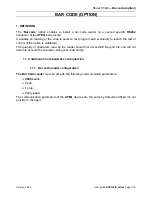
121
Data Protection
•
Battery Backup
The RAID controllers are armed with a Battery Backup Module (BBM). While an Uninterruptible Power
Supply (UPS) protects most servers from power fluctuations or failures, a BBM provides an additional level
of protection. In the event of a power failure, a BBM supplies power to retain data in the RAID
controller’s cache, thereby permitting any potentially dirty data in the cache to be flushed out to secondary
storage when power is restored.
The batteries in the BBM are recharged continuously through a trickle-charging process whenever the
system power is on. The batteries protect data in a failed server for up to three or four days, depending on
the size of the memory module. Under normal operating conditions, the batteries last for three years before
replacement is necessary.
•
Recovery ROM
RAID controller firmware is stored on the flash ROM and is executed by the I/O processor. The firmware can
also be updated through the RAID controllers PCIe bus port or Ethernet port without the need to replace
any hardware chips. During the controller firmware upgrade flash process, it is possible for a problem to
occur resulting in corruption of the controller firmware. With our Redundant Flash Image feature, the
controller will revert back to the last known version of firmware and continue operating. This reduces the
risk of system failure due to firmware crash.
Appendix G
Understanding RAID
RAID is an acronym for Redundant Array of Independent Disks. It is an array of multiple independent hard disk
drives that provides high performance and fault tolerance. The RAID controller implements several levels of the
Berkeley RAID technology. An appropriate RAID level is selected when the volume sets are defined or created. This
decision should be based on the desired disk capacity, data availability (fault tolerance or redundancy), and disk
performance. The following section discusses the RAID levels supported by the RAID controllers.
The RAID controllers make the RAID implementation and the disks’ physical configuration transparent to the host
operating system. This means that the host operating system drivers and software utilities are not affected,
regardless of the RAID level selected. Correct installation of the disk array and the controller requires a proper
understanding of RAID technology and the concepts.
RAID 0
RAID 0, also referred to as striping, writes stripes of data across multiple disk drives instead of just one disk drive.
RAID 0 does not provide any data redundancy, but does offer the best high-speed data throughput. RAID 0 breaks
up data into smaller blocks and then writes a block to each drive in the array. Disk striping enhances performance
because multiple drives are accessed simultaneously; the reliability of RAID level 0 is less because the entire array
will fail if any one disk drive fails.
Содержание ES208X12HP
Страница 1: ......





































